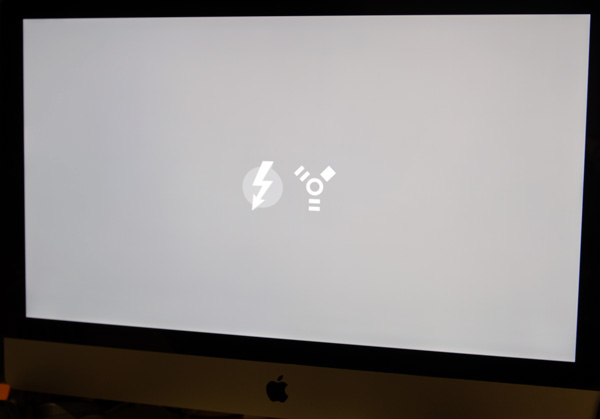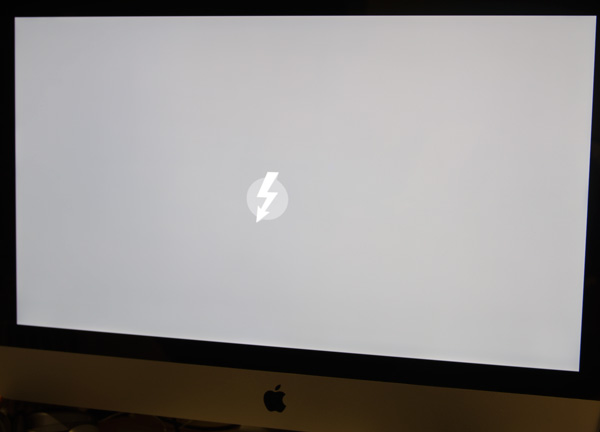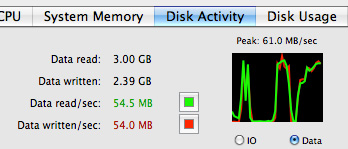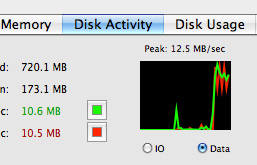Promise Pegasus R6 & Mac Thunderbolt Review
by Anand Lal Shimpi on July 8, 2011 2:01 AM ESTTarget Disk Mode
Another use of Thunderbolt is Target Disk Mode. Connect any two 2011 iMacs, 2011 MacBook Pros or any combination of the two with a Thunderbolt cable, reboot one of them while holding down the T key and you'll boot into target disk mode.

Hold down T and you'll get both Thunderbolt and FireWire logos at boot

With only Thunderbolt connected, the FireWire logo disappears - you're now in Target Disk Mode over TB
In this mode the target Mac boots into a special EFI state that allows all of its drives (HDDs, SSDs, optical, anything connected to the computer) to be mounted by the host Mac. The drives appear like normal removable disks on the host Mac:

MacBook Pro accessing the iMac's sole HDD over Thunderbolt in Target Disk Mode
You even have to eject them all manually before turning off the target Mac.
Don't get too excited though, since the target Mac isn't running full blown OS X it only implements basic storage drivers and optimizations. As a result, peak performance is no where near what Thunderbolt is capable of. Regardless of whether I put the 15-inch MacBook Pro or 27-inch iMac in target disk mode, I never saw more than 61MB/s from the target.

Performance was erratic as well. Sometimes I'd see transfer rates drop all the way down to 9MB/s before jumping up to 30MB/s and then 60MB/s. On average I'd say I saw transfers around 40MB/s.

The functionality is great, however I believe target disk mode would be a killer feature of Thunderbolt if it could operate at peak performance. In its current implementation, it's faster than a WiFi transfer but a bit slower than a good Gigabit Ethernet network transfer. If we could get line speed transfers, being able to move data between two modern Macs at multiple Gbps would be great.










88 Comments
View All Comments
enthios - Thursday, July 28, 2011 - link
"Ironically isolated from the world around them?" How about wifi and iCloud? With limited storage capacity, there's no need for anything more. iOS devices are simply thin clients - and they work wonderfully as such.NirXY - Friday, July 8, 2011 - link
Which is 0$Exelius - Friday, July 8, 2011 - link
Yes, but in this instance, it's not just a dumb wire; there is an IC at each end of the cable. So theoretically, if Intel comes up with an upgraded Light Peak spec, there may well be cables that are capable of faster speeds. I also imagine longer cables become more difficult, and may in fact require fiber optic transceivers built into the cable. This cable also likely costs significantly more to manufacture than a crimped cable, since there's a tiny IC and micro soldering that needs to be done on each cable.But yes, in one sense you are right that in a digital bus, higher quality cables do not provide better performance (though I have run into very low-quality HDMI cables that work fine at 720p but refuse to carry a 1080p signal.)
repoman27 - Sunday, July 10, 2011 - link
At the moment, i’m not sure the Thunderbolt host controller has any real legs on the cable. That host controller is already pumping data to each port at the same speeds as the DMI link between the CPU and PCH. Everything in the chain that is connected to it needs to get faster for Thunderbolt to get faster, i.e. PCIe 3.0, DMI 3.0, DP 1.2.Also, I’m pretty sure it’s not those little ICs that are making Apple’s Thunderbolt cables cost $49. Like many retailers, Apple knows that cables and accessories (and RAM upgrades) are a great place to stretch profit margins. A quick search of the Apple store for cables and adapters will turn up dozens of genuine Apple offerings ranging in price from $19 on up to $99. So, taken in context, the Thunderbolt cable is actually a mid-priced cable from Apple, not an expensive one. It also means that cheap unbranded alternatives could quite realistically be sold for around $15, ICs and all.
Regarding your HDMI cable experience, Category 1 or “Standard” HDMI cables are only rated for 1080i60, whereas Category 2 or “High Speed” cables will do 1080p60, 4K, 3D, Deep Color, etc. Older cables weren’t marked as such, and thus YMMV.
snakeInTheGrass - Friday, July 15, 2011 - link
Yeah, the SCSI cables were $75+ easily, you needed terminators, and do you remember the fine SCSI1/2/3 connector differences so you needed adapters or cables with different ends depending on the devices. I still have probably what WAS $500 of cables in my closed.Inflation adjusted, these $50 cables are about the equivalent of $15 cables back in those days, so frankly they don't sound too bad, especially considering the fact that it's industry leading performance right now.
As for comparing to Monster cables, these Thunderbolt cables have controllers built into them and presumably do have to meet tighter tolerances than USB, particularly as they carry 2 x 10Gbps data streams. But you're right that Monster cables are a rip off.
flowynn - Friday, July 8, 2011 - link
I remember those days well. My need for speed SCSI habit was insanely expensive.MonkeyPaw - Friday, July 8, 2011 - link
It reminds me of FB-DIMMs, an expensive solution that uses additional energy, and the components cost more than devices it replaces. Controllers in the cables AND on the motherboard and peripherals? Maybe the optical solution will make more sense.CrimsonFury - Monday, July 11, 2011 - link
I thought the initial copper cables didn't need any controllers in them? The impression I got from earlier articles was that Intel said their Thunderbolt implementation could scale to optical in future for greater speeds by releasing optical cables with a copper to optical controller in each end of the cable once controller costs had come down from mass production.MobiusStrip - Tuesday, July 12, 2011 - link
No, they need optical in the ports and wires.By reneging on the light in "Light Peak", Intel effectively killed it. Who knows why they're playing dumb in pretending that they're going to get the industry to adopt Thunderbolt and then turn around and adopt an optical solution right afterward. Just idiotic.
André - Friday, July 8, 2011 - link
I find it especially funny considering that all current Thunderbolt solutions (A/V equipment or storage enclosures) are all in excess of $999 to begin with.